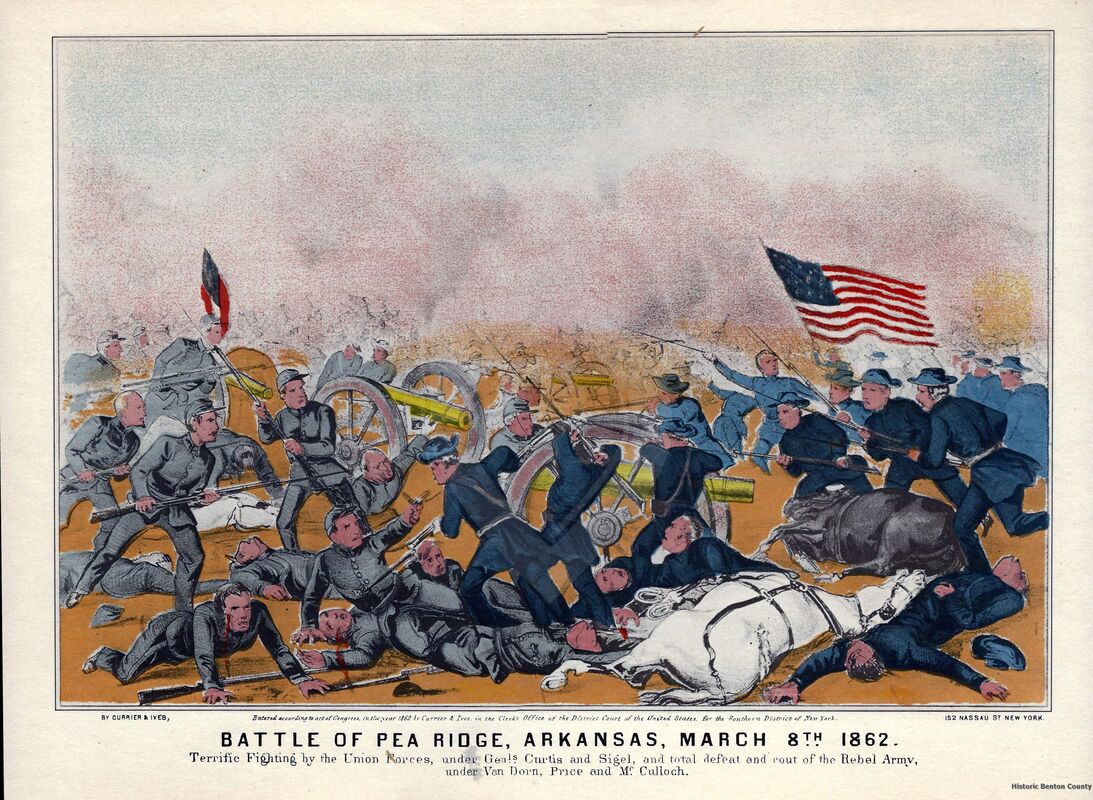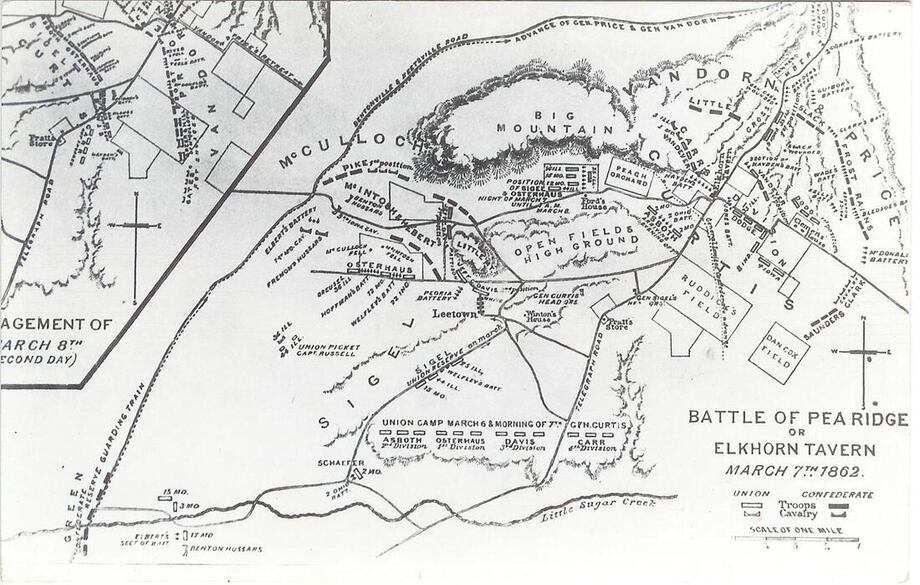Historians Consider Pea Ridge Most Important Battle Fought West of the Mississippi River
Article from the Rogers Daily News - May 25, 1963 (Now the NWA Democrat Gazette)
This is the second installment of a two part story. If you missed the first part, it is also in the "Stories of Benton County" section.
Article from the Rogers Daily News - May 25, 1963 (Now the NWA Democrat Gazette)
This is the second installment of a two part story. If you missed the first part, it is also in the "Stories of Benton County" section.
Editor's note -- The following is a digest of the account of the Battle of Pea Ridge as recorded by a History of Northwest Arkansas, published anonymously in 1888.
---------------------------------
---------------------------------
[This section begins with the account from the morning of March 8, 1862.]
Of the indian forces in McCulloch's column, Col. Drew, with his Cherokee regiment, retreated to the southwest toward Bentonville, while Col. Greer, who succeeded McCulloch in command of the wing, moved with the remainder of the force during the night and joined Van Dorn, taking position on his extreme left the next morning.
Col. Stand Watie, with his Cherokee regiment, retreated to Bentonville during the second day of the fight. It is said the hardest fighting of the battle took place between forces of the Confederate left and the Union right. When the battle opened the position held by the Union right was stoutly maintained, and it was with a fearful struggle and heavy loss to both sides that they were dislodged and compelled to fall back. With repeated attacks on the Union lines it was compelled to fall back, so that when the day's engagement closed, the left of the right wing rested near the foot of Big mountain and the right a short distance east of Pratt's store. This was confronted by the advanced line of the Confederates, who had captured Elkhorn Tavern and formed their lines west and south of the tavern, with their right resting at the foot of the mountain.
The withdrawal of the Confererates' right wing from in front of the Union left enabled Sigel to move eastward, with the division of Osterhaus along the south side of the mountain, to the relief and support of the right wing, which had been sorely pressed during the day.
During the night of March 7, the division of Col. Davis was called in from Leetown, and this brought the Union army all together.
On the first day of the fight while Van Dorn and Price were vigorously pushing their columns forward with marked success, they hoped that the right wing under McCullough was equally successful. But learning of his death, and that of McIntosh, the repulse of the right wing, and the state of affairs in general, Van Dorn concluded to retreat. During the night, Green's division, which had been left back on Sugar creek to guard the wagon train, was ordered to fall back and secure the train from exposure to capture.
Early on the morning of March 8 the Union line was re-formed with the division of Asboth on the left (near the mountain), Osterhaus' division in the center, and that of Davis on the right. Carr's division was in a retired position to the rear of Davis' right and immediately in front of Pratt's store, the whole facing generally to the eas tand confronting the Confederate line.
Of the indian forces in McCulloch's column, Col. Drew, with his Cherokee regiment, retreated to the southwest toward Bentonville, while Col. Greer, who succeeded McCulloch in command of the wing, moved with the remainder of the force during the night and joined Van Dorn, taking position on his extreme left the next morning.
Col. Stand Watie, with his Cherokee regiment, retreated to Bentonville during the second day of the fight. It is said the hardest fighting of the battle took place between forces of the Confederate left and the Union right. When the battle opened the position held by the Union right was stoutly maintained, and it was with a fearful struggle and heavy loss to both sides that they were dislodged and compelled to fall back. With repeated attacks on the Union lines it was compelled to fall back, so that when the day's engagement closed, the left of the right wing rested near the foot of Big mountain and the right a short distance east of Pratt's store. This was confronted by the advanced line of the Confederates, who had captured Elkhorn Tavern and formed their lines west and south of the tavern, with their right resting at the foot of the mountain.
The withdrawal of the Confererates' right wing from in front of the Union left enabled Sigel to move eastward, with the division of Osterhaus along the south side of the mountain, to the relief and support of the right wing, which had been sorely pressed during the day.
During the night of March 7, the division of Col. Davis was called in from Leetown, and this brought the Union army all together.
On the first day of the fight while Van Dorn and Price were vigorously pushing their columns forward with marked success, they hoped that the right wing under McCullough was equally successful. But learning of his death, and that of McIntosh, the repulse of the right wing, and the state of affairs in general, Van Dorn concluded to retreat. During the night, Green's division, which had been left back on Sugar creek to guard the wagon train, was ordered to fall back and secure the train from exposure to capture.
Early on the morning of March 8 the Union line was re-formed with the division of Asboth on the left (near the mountain), Osterhaus' division in the center, and that of Davis on the right. Carr's division was in a retired position to the rear of Davis' right and immediately in front of Pratt's store, the whole facing generally to the eas tand confronting the Confederate line.
The Confederate line, as formed on the morning of March 8, was: Little on the right, next to the mountain and directly in front of the Union forces under Osterhaus and Asboth; Frost next on the left; Greer and Hill next, with Gates' cavalry on the extreme left. Gen. Curtis opened the battle on the second morning with cannonading, and having selected a good position he moved on the Confederate forces, who seemed to fight more on the defensive than on the offensive, as they did the day before.
However, opposite the left of the Union line near Elkhorn Tavern, Van Dorn made a determined effort to hold the spur of hills, the top of which was crowned and protected by rocks and boulders. Some of Price's infantry had already taken possession of it, and a battery was being placed in postion when Hoffman's and Elbert's batteries were ordered to direct their fire against them, chiefly with solid shot. Not more than 15 minutes elapsed before the Confederates evacuated this last stronghold.
About the same time two Union regiments advanced from the center and right into the woods, engaged the Confederate infantry and drove it back, and another Union regiment, the Twelfth Missouri capture the Dallas battery. At this juncture the Union right advanced to the Confederate left, the latter yielding,and the general retreat of the Confederate army now began.
However, opposite the left of the Union line near Elkhorn Tavern, Van Dorn made a determined effort to hold the spur of hills, the top of which was crowned and protected by rocks and boulders. Some of Price's infantry had already taken possession of it, and a battery was being placed in postion when Hoffman's and Elbert's batteries were ordered to direct their fire against them, chiefly with solid shot. Not more than 15 minutes elapsed before the Confederates evacuated this last stronghold.
About the same time two Union regiments advanced from the center and right into the woods, engaged the Confederate infantry and drove it back, and another Union regiment, the Twelfth Missouri capture the Dallas battery. At this juncture the Union right advanced to the Confederate left, the latter yielding,and the general retreat of the Confederate army now began.
The Confederates fell back over the same ground they had gained the day before, and the main army, which remained in order, retreated to the southeast on the Van Winkle road. Some detachments cut off from the main army retreated in other directions, being followed by Union forces toward Keetsville, in Missouri, and to a point beyond Bentonville.
It was claimed by those serving in the Confederate army that Van Dorn's only object in maintaining the fight on the second day was to enable his trains and forces to make a successful retreat. The retreat took place before noon.
The Union army remained on the field, having won the victory which the Confederates felt confident of winning on the first day of the fight.
The Union victory at Elkhorn Tavern was considered great for the Union cause, inasmuch as it, to a great extent, kept the war out of Missouri for the next two years, and completely completely defeated Van Dorn's contemplated project to capturing St. Louis and extending the war into Illinois.
On the second day of the battle at Elkhorn Tavern, Brig. Gen. William Y. Slack, commanding a force under Gen. Price, was mortally wounded in a charge made on a part of the Union-line. His home was at Chilicothe, Mo. He was a lawyer by profession, and a captain in the Mexican war under Sterling Price, who was then a colonel.
The composition, strength and losses of the contending armies at Elkhorn Tavern were:
Union army; Brig. Gen. Samuel R. Curtis, commander: First and Second divisions, Brig. Gen. Franz Sigel; First division, consisting of two brigades of infantry and two batteries of artillery, commanded by Col. Peter J. Osterhaus; Second division, consisting of the First Brigade, some unattached troops and two batteries, Brig. Gen. Alexander Asboth; Third division, consisting of two brigades, one battery and some cavalry, Col. Jeff C. Davis; Fourth division, consisting of two brigades, one battery, and some unattached cavalry and infantry, Col. Eugene A. Carr.
Effective forces of the Union army, 10,500 infantry and cavalry, with 49 pieces of artillery. A total loss of Union army, 203 killed, 980 wounded and 201 captured or missing. Total: 1,384.
Confederate army: Maj. Gen. Earl Van Dorn, commander; Missouri State Guards, Maj. Gen. Sterling Price; Confederate Volunteers, various commands; State troops, Second, Third, Fifth, Sixth, Seventh, Eighth and Ninth divisions (various commands) Brig. Gen. Ben McCulloch; Pike's command, consisting of Indians and a squadron of Texas cavalry, Brig. Gen. Albert Pike.
Effective force of Confederate army: Price"s command, 6,818, with eight batteries of artillery: McCulloch's comand, 8,364, with four batteries of 18 pieces: Pikes's command, 1,000. Aggregate 16,202 infantry and cavalry.
The Confederate loss has been reported at 800 to 1,000 killed and wounded, and between 200 and 300 prisoners. These figures would make the Confederate losses about equal those of the Union army.
It was claimed by those serving in the Confederate army that Van Dorn's only object in maintaining the fight on the second day was to enable his trains and forces to make a successful retreat. The retreat took place before noon.
The Union army remained on the field, having won the victory which the Confederates felt confident of winning on the first day of the fight.
The Union victory at Elkhorn Tavern was considered great for the Union cause, inasmuch as it, to a great extent, kept the war out of Missouri for the next two years, and completely completely defeated Van Dorn's contemplated project to capturing St. Louis and extending the war into Illinois.
On the second day of the battle at Elkhorn Tavern, Brig. Gen. William Y. Slack, commanding a force under Gen. Price, was mortally wounded in a charge made on a part of the Union-line. His home was at Chilicothe, Mo. He was a lawyer by profession, and a captain in the Mexican war under Sterling Price, who was then a colonel.
The composition, strength and losses of the contending armies at Elkhorn Tavern were:
Union army; Brig. Gen. Samuel R. Curtis, commander: First and Second divisions, Brig. Gen. Franz Sigel; First division, consisting of two brigades of infantry and two batteries of artillery, commanded by Col. Peter J. Osterhaus; Second division, consisting of the First Brigade, some unattached troops and two batteries, Brig. Gen. Alexander Asboth; Third division, consisting of two brigades, one battery and some cavalry, Col. Jeff C. Davis; Fourth division, consisting of two brigades, one battery, and some unattached cavalry and infantry, Col. Eugene A. Carr.
Effective forces of the Union army, 10,500 infantry and cavalry, with 49 pieces of artillery. A total loss of Union army, 203 killed, 980 wounded and 201 captured or missing. Total: 1,384.
Confederate army: Maj. Gen. Earl Van Dorn, commander; Missouri State Guards, Maj. Gen. Sterling Price; Confederate Volunteers, various commands; State troops, Second, Third, Fifth, Sixth, Seventh, Eighth and Ninth divisions (various commands) Brig. Gen. Ben McCulloch; Pike's command, consisting of Indians and a squadron of Texas cavalry, Brig. Gen. Albert Pike.
Effective force of Confederate army: Price"s command, 6,818, with eight batteries of artillery: McCulloch's comand, 8,364, with four batteries of 18 pieces: Pikes's command, 1,000. Aggregate 16,202 infantry and cavalry.
The Confederate loss has been reported at 800 to 1,000 killed and wounded, and between 200 and 300 prisoners. These figures would make the Confederate losses about equal those of the Union army.


